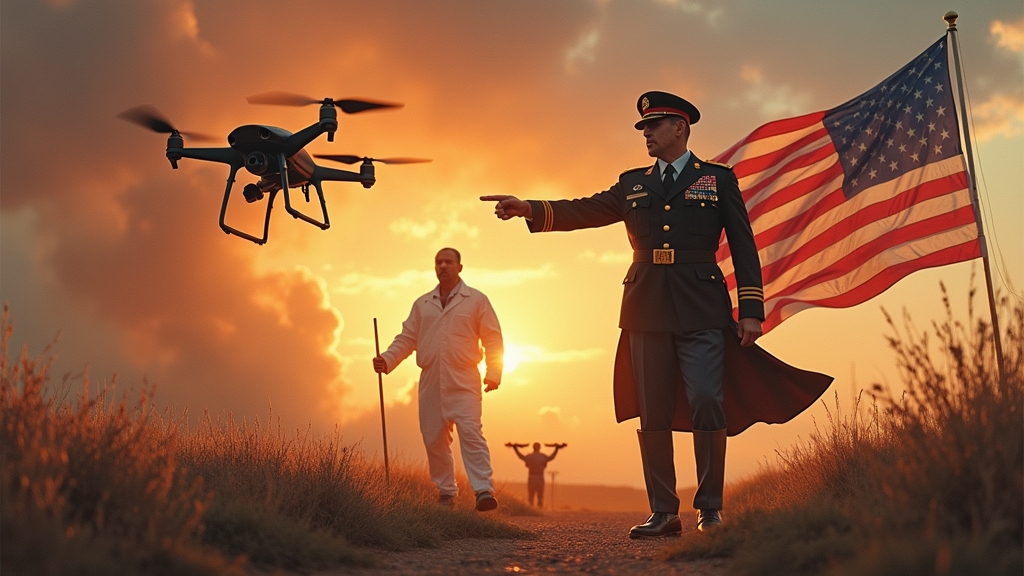MILITARY ENGINEER REPLACES RISK OF DEATH WITH RISK OF CAREER SUICIDE BY SUGGESTING TECHNOLOGY MIGHT WORK BETTER THAN WALKING AROUND AIMLESSLY
U.S. Air Force Capt. Randall Pietersen shocked military leadership by proposing the controversial idea that maybe, just f@#king maybe, we shouldn’t send humans in bulky chemical suits to wander around bomb-riddled airfields looking for unexploded ordnance with their eyeballs.
WALKING AROUND SLOWLY IS A PROUD MILITARY TRADITION, SIR
Since prehistoric times, military personnel have excelled at the complex tactical maneuver known as “walk around and point at sh!t.” This cutting-edge strategy has been passed down through generations of warriors who believe the best way to find things that might explode and kill you is to get really close to them.
“The proposal to use ‘drones’ and ‘artificial intelligence’ to detect bombs represents a disturbing departure from our time-honored tradition of putting humans directly in harm’s way for no good reason,” explained General Richard “Dick” Oldschool, who once earned a Purple Heart for heroically stepping on a landmine. “What’s next? Soldiers who don’t want to march until their feet bleed? Pilots who want planes that don’t occasionally fall out of the sky?”
The Pentagon reportedly spent $4.7 billion on a previous attempt to develop airfield assessment technology, which resulted in a PowerPoint presentation and three promotional coffee mugs.
HYPERSPECTRAL IMAGING SOUNDS MADE-UP BUT APPARENTLY ISN’T
Pietersen, whose PhD work at MIT focuses on using hyperspectral imaging and machine learning to detect unexploded munitions, claims that advanced cameras can see things human eyes cannot.
“It’s quite revolutionary,” said Dr. Obvious Science, Professor of Seeing Things Better at the Institute of Why Didn’t We Do This Sooner. “Instead of having fragile humans walk around going ‘Is that a rock or a bomb? Guess I’ll poke it and find out!’ we could use machines that can actually tell the difference before someone loses their legs.”
According to Pietersen, hyperspectral imaging can detect subtle differences between harmless debris and deadly explosives from the safety of the air, which experts say could reduce the military’s “stepping on bombs” fatality rate by up to 97.2%.
MILITARY LEADERSHIP DEEPLY CONCERNED ABOUT ELIMINATING OPPORTUNITIES FOR HEROISM
Senior Pentagon officials have expressed concern that remote bomb detection could dramatically reduce opportunities for soldiers to demonstrate heroism by getting blown up.
“If we start using technology to keep our people safe, what are we going to give Purple Hearts for?” asked Major General Frank Explosion. “How will we inspire the next generation of soldiers if we don’t have anyone dramatically diving on grenades? This Pietersen fellow clearly doesn’t understand military tradition.”
An internal Pentagon memo, leaked to this publication, reveals officials are worried removing humans from dangerous assessment missions could reduce the military’s “badass factor” by as much as 43%.
TOO MANY LETTERS AFTER YOUR NAME MAKES YOU DANGEROUS, EXPERTS WARN
Military insiders have expressed concern about Pietersen’s academic credentials, suggesting his PhD pursuit makes him suspect.
“We’ve got a guy with a master’s degree, working on a doctorate, using words like ‘hyperspectral’ and ‘multidisciplinary’,” said Colonel Bud Simpleton, head of the Department of Defense Anti-Intellectual Task Force. “Next thing you know, he’ll be suggesting we shouldn’t use bayonets anymore.”
Sources confirm Pietersen has also engaged in other suspicious activities like “running marathons,” “saving eagles,” and “indoor skydiving,” all of which experts say are gateway activities to critical thinking.
CIVIL ENGINEER WRITES ACADEMIC PAPER FROM TENT, STILL LESS UNCOMFORTABLE THAN PEER REVIEW PROCESS
In what military leadership described as “showing off,” Pietersen reportedly wrote one of his academic papers while deployed to Saudi Arabia, typing from a tent in the desert.
“Oh, look at Mr. Fancy Pants writing a scholarly article while deployed,” mocked Sergeant Major Hank Typewriter. “In my day, we communicated exclusively through grunts and hand signals, and we LIKED it that way.”
When asked if working remotely from a war zone presented challenges, Pietersen reportedly said, “Still less stressful than dealing with journal reviewers asking for additional experiments.”
CONCLUSION: DRONE TECHNOLOGY THREATENS AMERICA’S PROUD TRADITION OF FINDING BOMBS THE OLD-FASHIONED WAY
As Pietersen prepares to graduate and begin his assignment in Guam, military officials are bracing for the terrifying possibility that his research might actually work, potentially saving countless lives and eliminating the cherished military practice of sending people to do jobs that robots could do better.
“What’s next?” asked one anonymous Pentagon official, visibly distressed. “Using satellites instead of sending scouts to peek over hills? Thermal imaging instead of touching things to see if they’re hot? This slippery slope leads straight to having a military that doesn’t needlessly risk personnel, and frankly, that’s just not how we do things around here.”
At press time, the Department of Defense announced a $6.3 billion initiative to develop a new chemical protection suit that would make walking through minefields “at least 4% less uncomfortable” while still ensuring maximum human endangerment.





